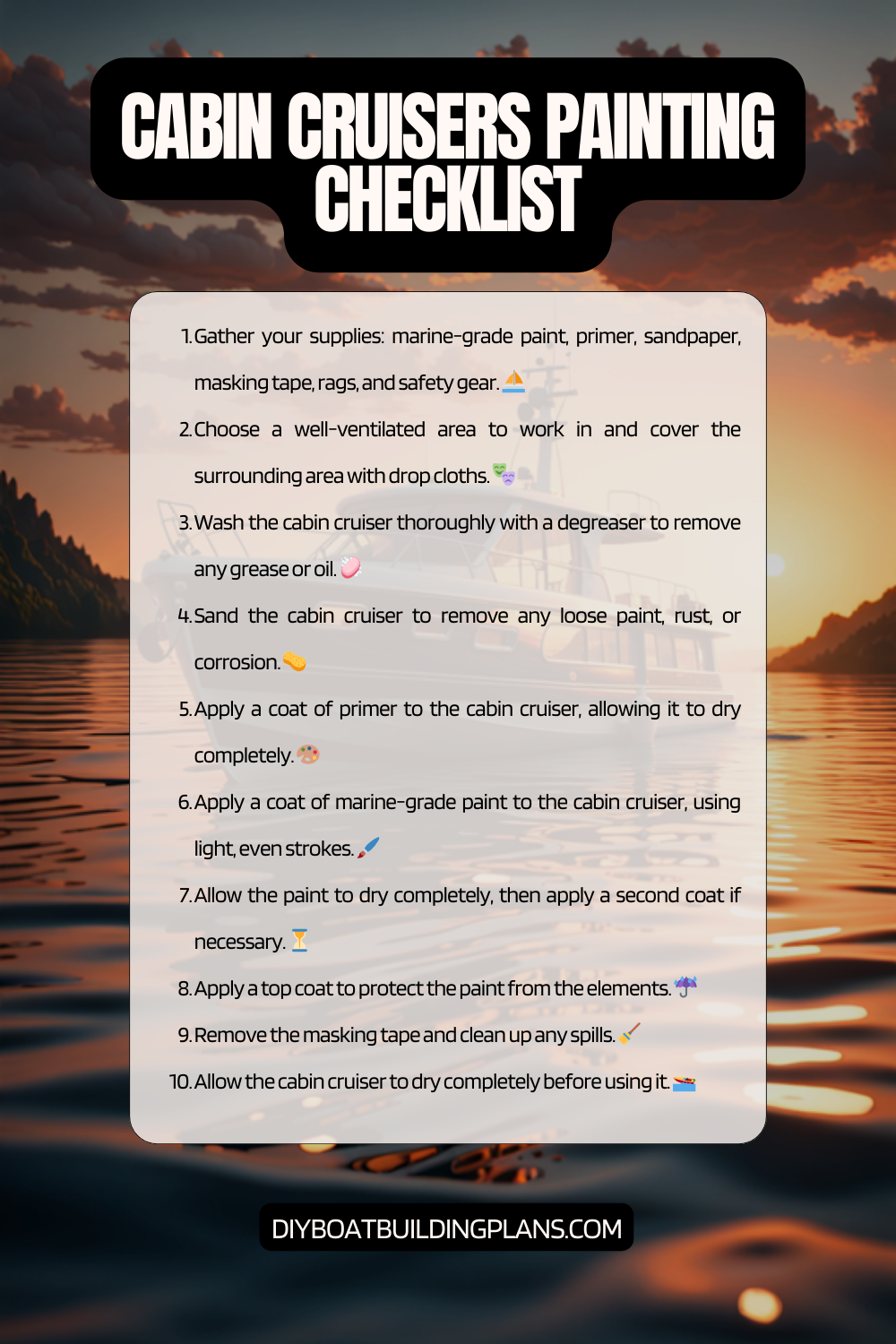Overview of Cabin Cruiser Painting Tips
Maintaining a cabin cruiser’s paint job is crucial for both aesthetic and functional reasons. The paint not only enhances the appearance of the boat but also acts as a protective layer against the harsh marine environment. However, there are several factors that can affect the quality of the paint job, such as exposure to saltwater, UV rays, and general wear and tear. In order to ensure a long-lasting and beautiful finish, it is important to follow proper painting techniques and take necessary precautions.
Key Takeaways
- Properly preparing the surface is crucial for a successful cabin cruiser painting project.
- Choosing the right paint and sanding technique can make a big difference in the final result.
- Priming your cabin cruiser before painting is essential for a long-lasting finish.
- Brush, roller, or spray? The painting method you choose depends on your skill level and the size of your boat.
- Regular maintenance is key to keeping your cabin cruiser’s paint job looking great.

Preparing the Surface: The First Step in Cabin Cruiser Painting
Preparing the surface of a cabin cruiser before painting is essential for achieving a smooth and durable finish. This step involves removing any existing paint, cleaning the surface thoroughly, and repairing any damages or imperfections. By doing so, you create a clean canvas for the new paint to adhere to, ensuring better adhesion and longevity.
To prepare the surface of your cabin cruiser, start by removing any loose or flaking paint using a scraper or sandpaper. Next, wash the boat with a mild detergent and water to remove dirt, grime, and any remaining residue. It is important to pay attention to areas that are prone to buildup, such as the waterline or areas around fittings and hardware.
Choosing the Right Paint for Your Cabin Cruiser
Choosing the right paint for your cabin cruiser is crucial for achieving a long-lasting and high-quality finish. There are several factors to consider when selecting paint, such as durability, color options, and compatibility with your boat’s material.
When choosing paint for your cabin cruiser, consider the type of material your boat is made of. Fiberglass boats require specific types of paint that are designed to adhere to the surface properly. On the other hand, aluminum boats may require specialized marine-grade paints that are resistant to corrosion.
Tips for Sanding Your Cabin Cruiser Before Painting
| Step | Description |
|---|---|
| 1 | Remove all hardware and fittings from the boat. |
| 2 | Use a power sander with 80-grit sandpaper to remove any old paint or varnish. |
| 3 | Switch to a 120-grit sandpaper to smooth out any rough spots. |
| 4 | Fill any cracks or holes with wood filler and sand smooth. |
| 5 | Wipe down the boat with a tack cloth to remove any dust. |
| 6 | Apply a coat of primer to the boat and let dry. |
| 7 | Sand the primer with 220-grit sandpaper to create a smooth surface. |
| 8 | Apply two coats of paint, sanding with 220-grit sandpaper between coats. |
| 9 | Reinstall all hardware and fittings. |
Sanding is an important step in the cabin cruiser painting process as it helps to create a smooth and even surface for the paint to adhere to. It also helps to remove any remaining traces of old paint, dirt, or imperfections.
Before sanding your cabin cruiser, make sure to wear protective gear such as goggles and a dust mask to protect yourself from dust particles. Start by using coarse-grit sandpaper to remove any existing paint or imperfections. Gradually move to finer-grit sandpaper to achieve a smoother finish.
How to Prime Your Cabin Cruiser for Painting
Priming your cabin cruiser before painting is essential for ensuring better adhesion and durability of the paint. Primer acts as a bonding agent between the surface and the paint, creating a strong foundation for the topcoat.
To prime your cabin cruiser, start by selecting a high-quality marine-grade primer that is compatible with your chosen paint. Apply the primer evenly using a brush or roller, following the manufacturer’s instructions. Make sure to cover all areas of the boat, including hard-to-reach spots and corners.
Painting Your Cabin Cruiser: Brush, Roller, or Spray?
When it comes to painting your cabin cruiser, you have several options: brush, roller, or spray. Each method has its own pros and cons, and the choice depends on personal preference and the size of the boat.
Brush painting is a traditional method that allows for better control and precision. It is ideal for smaller areas or intricate details. However, it can be time-consuming and may leave brush marks if not applied properly.
Roller painting is a faster method that provides good coverage and a smooth finish. It is suitable for larger areas and can save time compared to brush painting. However, it may not be as precise in reaching tight corners or edges.
Spray painting is a popular choice for larger boats as it provides an even and professional-looking finish. It allows for quick application and can cover large areas efficiently. However, it requires proper equipment and technique to avoid overspray and achieve an even coat.
Tips for Achieving a Smooth Finish on Your Cabin Cruiser
Achieving a smooth finish on your cabin cruiser is essential for a professional-looking paint job. Here are some tips to help you achieve a smooth finish:
– Use high-quality paint and tools: Investing in good quality paint and tools can make a significant difference in the final result. Cheap brushes or rollers may leave streaks or brush marks, while low-quality paint may not provide good coverage or durability.
– Apply thin coats: It is better to apply multiple thin coats rather than one thick coat. Thin coats dry faster and are less likely to drip or sag, resulting in a smoother finish.
– Sand between coats: Sanding between coats helps to remove any imperfections or rough spots, creating a smoother surface for the next coat of paint. Use fine-grit sandpaper and wipe away any dust before applying the next coat.
Dealing with Rust and Corrosion on Your Cabin Cruiser
Rust and corrosion can be a common issue for cabin cruisers, especially those exposed to saltwater. These can not only affect the appearance of the boat but also compromise its structural integrity if left untreated.
To prevent rust and corrosion, it is important to regularly inspect your boat for any signs of damage or wear. Keep an eye out for areas where paint has chipped or peeled off, as these are vulnerable spots. If you notice any rust or corrosion, it is crucial to address it immediately.
Protecting Your Cabin Cruiser from Sun Damage
Sun damage can have a detrimental effect on your cabin cruiser’s paint job. UV rays can cause the paint to fade, crack, or peel over time. To protect your boat from sun damage, consider the following tips:
– Use UV-resistant paint: Opt for paints that are specifically designed to withstand UV rays. These paints have additives that help to protect the surface from fading or deteriorating.
– Apply a clear coat: Applying a clear coat over the paint can provide an extra layer of protection against UV rays. Clear coats are transparent and do not alter the color of the paint.
– Regularly wax your boat: Waxing your boat can help to protect the paint from UV rays and other environmental factors. It creates a barrier that prevents dirt, salt, and other contaminants from adhering to the surface.
Maintaining Your Cabin Cruiser’s Paint Job: Tips and Tricks
Maintaining your cabin cruiser’s paint job is essential for preserving its appearance and longevity. Here are some tips to help you maintain your boat’s paint job:
– Wash your boat regularly: Regularly washing your boat with mild detergent and water helps to remove dirt, salt, and other contaminants that can damage the paint. Use a soft sponge or brush to avoid scratching the surface.
– Avoid abrasive cleaners: Avoid using abrasive cleaners or harsh chemicals that can strip away the paint or cause damage. Stick to mild detergents or cleaners specifically designed for marine use.
– Touch up any chips or scratches: Keep an eye out for any chips or scratches in the paint and touch them up as soon as possible. This prevents further damage and helps to maintain the integrity of the paint job.
Download over 500 Boat Plans. Click on the link below.
-->Click Here<--
Common Mistakes to Avoid When Painting Your Cabin Cruiser
When painting your cabin cruiser, it is important to avoid common mistakes that can compromise the quality of the paint job. Here are some mistakes to watch out for:
– Skipping surface preparation: Skipping or rushing through the surface preparation process can result in poor adhesion and a shorter lifespan for the paint job. Take the time to properly clean, sand, and prime the surface before painting.
– Applying too thick of a coat: Applying too thick of a coat can lead to drips, sags, and an uneven finish. It is better to apply multiple thin coats for better coverage and a smoother finish.
– Ignoring safety precautions: Painting can involve exposure to harmful fumes and chemicals. It is important to wear protective gear such as goggles, gloves, and a respirator to protect yourself from potential health hazards.
Cabin Cruiser Painting Checklist

Conclusion – Cabin Cruiser Painting Tips
In conclusion, maintaining a cabin cruiser’s paint job is crucial for both aesthetic appeal and protection against the elements. By following proper painting techniques, choosing the right paint, and taking necessary precautions, you can achieve a long-lasting and beautiful finish. Remember to prepare the surface properly, choose the right paint for your boat’s material, and follow the recommended steps for sanding, priming, and painting. Regular maintenance and avoiding common mistakes will help ensure that your cabin cruiser’s paint job remains in top condition for years to come.
FAQs – Cabin Cruiser Painting Tips
What is a cabin cruiser?
A cabin cruiser is a type of powerboat that is designed for leisure activities such as cruising, fishing, and water sports. It typically has a cabin or living quarters below deck.
Why should I paint my cabin cruiser?
Painting your cabin cruiser can help protect it from the elements, prevent corrosion, and improve its appearance. It can also increase its resale value.
What type of paint should I use for my cabin cruiser?
Marine-grade paint is recommended for cabin cruisers as it is designed to withstand the harsh marine environment. It is typically more durable and resistant to fading, chalking, and peeling than regular paint.
How do I prepare my cabin cruiser for painting?
Before painting your cabin cruiser, you should clean and sand the surface to remove any dirt, grime, or old paint. You should also repair any cracks, dents, or other damage to the surface.
What tools do I need to paint my cabin cruiser?
You will need a variety of tools to paint your cabin cruiser, including brushes, rollers, spray guns, sandpaper, masking tape, and drop cloths. The specific tools you need will depend on the size and complexity of your boat.
How many coats of paint should I apply?
It is recommended to apply at least two coats of paint to ensure adequate coverage and protection. However, the number of coats you need may vary depending on the type of paint you are using and the condition of your boat’s surface.
How long does it take to paint a cabin cruiser?
The time it takes to paint a cabin cruiser will depend on the size and complexity of your boat, as well as the type of paint you are using. It can take anywhere from a few days to several weeks to complete the painting process.



